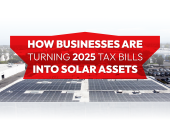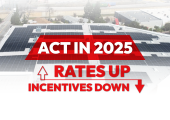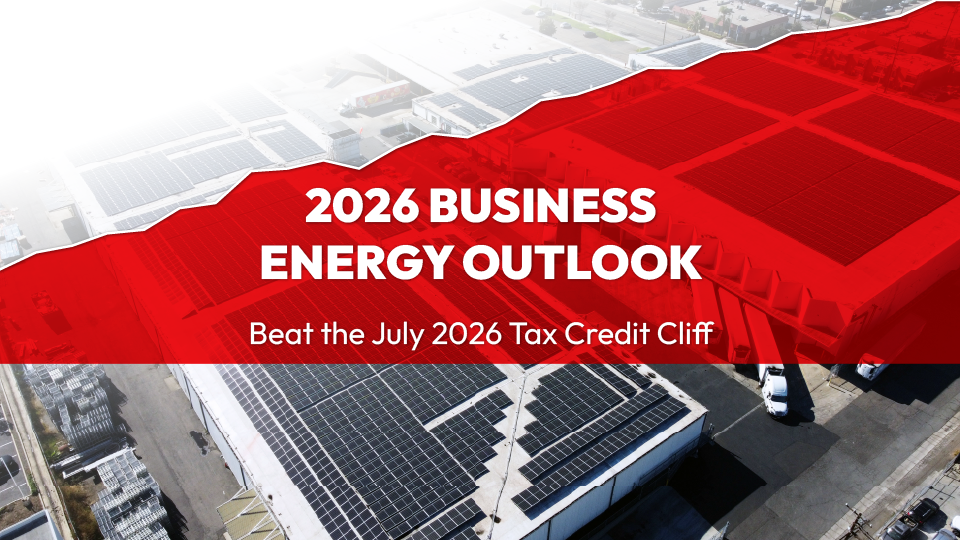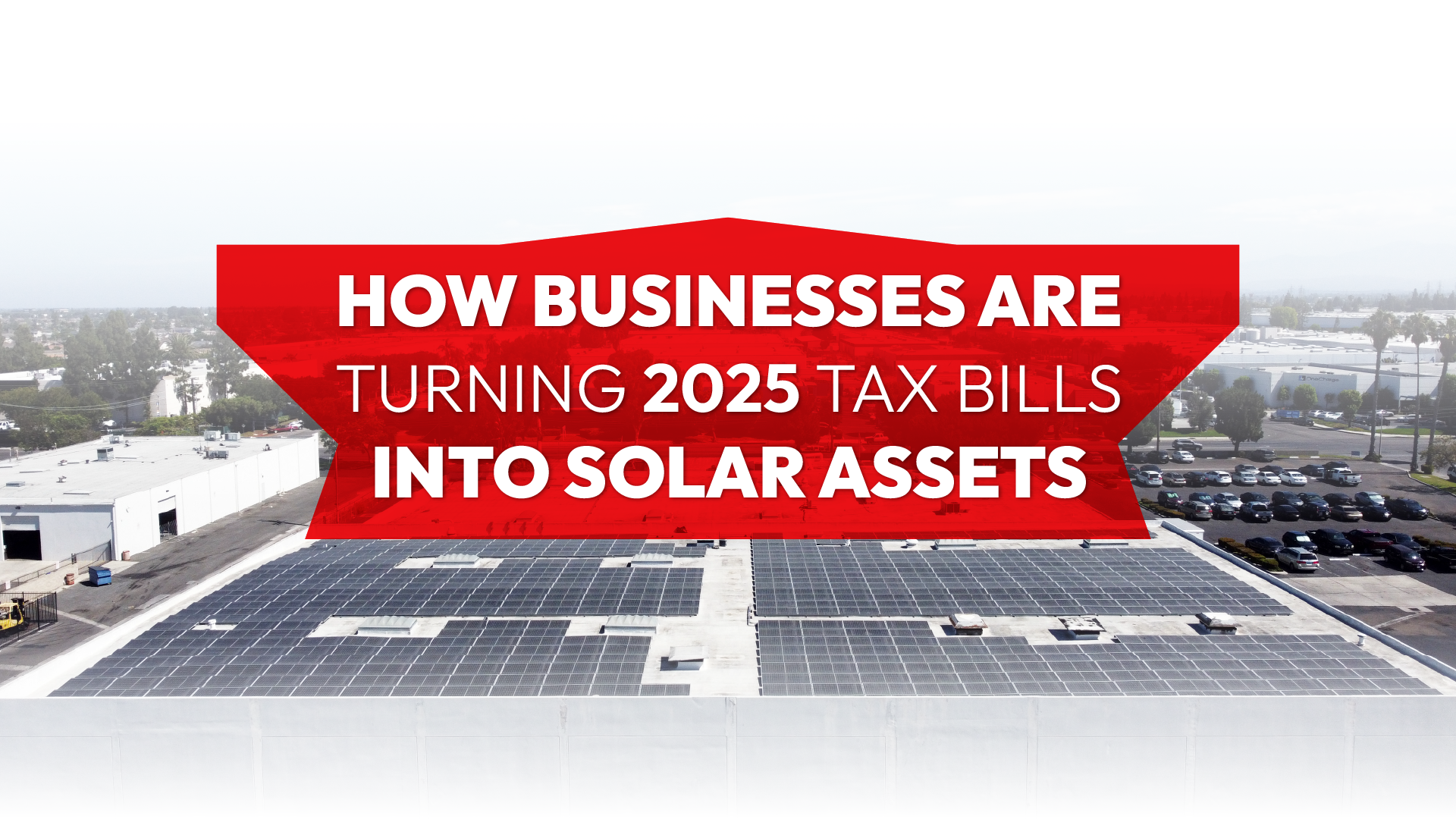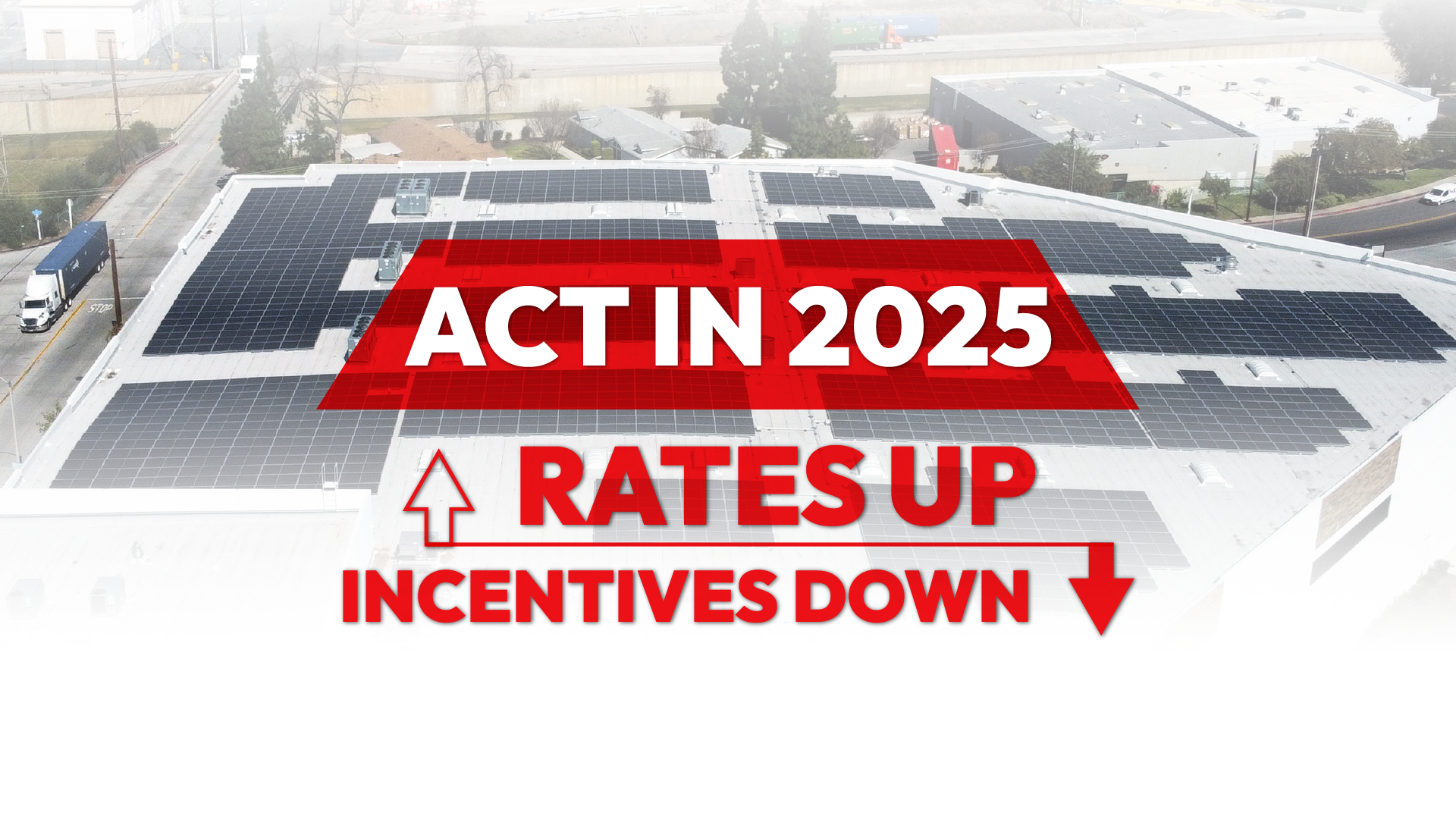The Solar Investment Tax Credit (ITC) remains one of the most impactful drivers of renewable energy adoption in the United States. First enacted in 2006, it has helped shrink solar costs by more than 80% and enabled the installation of tens of gigawatts (GW) of solar—transforming solar from niche to mainstream within two decades.
In 2025, businesses and property owners face a critical moment: it is the last year to secure the ITC at its full strength before new Foreign Entity of Concern (FEOC) sourcing restrictions take effect in 2026. These restrictions will make it harder to qualify for credits and are expected to increase project costs. Acting in 2025 ensures access to the maximum value of today’s incentives without the added hurdles coming next year.
So, whether you’re evaluating a new solar installation, considering upgrades with battery storage technology, or exploring bonus credits tied to domestically sourced materials, 2025 is the year to act if you want to lock in the strongest financial and policy advantages.
What Is the ITC for Solar?
The ITC for solar, or the federal solar investment tax credit, allows businesses, nonprofits, and homeowners to deduct a percentage of their solar energy system installation costs from their federal tax liability.
- Current Rate (2025): Businesses and nonprofit/commercial entities are eligible for a 30% investment tax credit if projects meet prevailing wage and apprenticeship requirements; otherwise, base rates may drop significantly. It’s important to note that this full value is only guaranteed in 2025—future years bring both a phase-down for residential credits and FEOC sourcing restrictions that will raise costs.
- Eligible Costs: Households benefit similarly with a 30% Residential Clean Energy Credit through 2032, phasing to 26% in 2033 and 22% in 2034.
The ITC is codified in Section 48 of the Internal Revenue Code and reinforced under Public Law 117-169. Unlike subsidies that directly pay installers, the ITC reduces a taxpayer’s tax liability, helping offset both capital expenditures and ongoing costs for solar generation projects.
Why the ITC Matters
The ITC isn’t just a financial perk—it’s a national policy that reshaped the landscape of renewable energy sources in the United States. By lowering costs, the ITC has:
- Spurred billions in private-sector investment.
- Increased federal revenues through job creation and economic activity, as reported by the Congressional Budget Office.
- Helped reduce carbon dioxide emissions by accelerating the replacement of fossil fuels with solar electric power, wind developments, and carbon sequestration strategies.
- Supported innovation across the solar storage industries, including fuel cells, heat pumps, and combined heat and power systems.
For property owners, the ITC is the single most important incentive to reduce solar costs and improve long-term system performance.
Key Updates After the Inflation Reduction Act
Now that the Inflation Reduction Act (IRA) has redefined clean energy incentives, the ITC looks very different than it did just a few years ago. Signed into law in 2022, the IRA not only extended the federal solar investment tax credit but also enhanced it with new features that reward innovation, equity, and sustainability. For commercial solar projects in California, these updates can mean the difference between a project that merely offsets energy costs and one that delivers maximum long-term financial and environmental impact.
Here are the most important updates you need to know:
1. Direct Pay for Tax-Exempt Entities
Previously, tax-exempt entities—such as schools, churches, municipalities, and nonprofit organizations—were unable to benefit from the ITC because they had no tax liability to offset. The IRA introduced the Direct Pay option, allowing these entities to receive a direct reimbursement from the Treasury Department. This change ensures that critical organizations in every community can now participate in renewable energy adoption and build resilient power projects without losing out on incentives.
2. Transferability of Credits
The updated ITC allows for transferability, meaning credits can be sold to other taxpayers. This has opened new financing pathways, particularly for developers who can now attract private-sector investment by selling credits. The system creates more liquidity in the market and helps ensure that projects in different geographic areas can move forward, even if the developers don’t have enough federal tax liability themselves.
3. Bonus Credits for Equity and Domestic Manufacturing
One of the IRA’s most important updates is the introduction of bonus credits:
- Domestic Content Bonus: Projects that meet U.S. sourcing thresholds (e.g., ≥45% domestic components for projects beginning in 2025) receive a +10 percentage‑point bonus to the ITC—boosting it from 30% to up to 40%.
- Low‑Income Communities Bonus: Eligible commercial/solar projects sited in underserved or LMI communities may earn an additional 10–20% bonus, potentially taking the ITC up toward 50 % total. These “adders” can combine (e.g., base 30% + 10% domestic + up to 20% low‑income = up to 60%).
- Energy Communities Bonus: Projects in formerly coal‑reliant or industrial transition areas (“energy communities”) can gain another +10 %.
4. Prevailing Wage & Apprenticeship Requirements
To qualify for the full base and any bonus credits, projects must meet wage and apprenticeship standards. Failure to satisfy these can dramatically reduce credits—to as low as ~6% of investment for non‑compliant projects.
5. Expanded Eligible Technologies
The ITC has also expanded to cover a broader range of renewable energy sources beyond traditional solar photovoltaic systems. Eligible technologies now include:
- Battery storage technology (standalone or paired with solar).
- Geothermal heat pumps for heating and cooling.
- Fuel cells – which play a role in hydrogen innovation.
- Heat pumps and combined heat and power systems.
- Advanced solar water heaters and solar roofing tiles.
This expansion demonstrates how federal policy is adapting to encompass the full ecosystem of solar developments, solar storage industries, and next-generation renewable technologies.
However, beginning in 2026, “Foreign Entity of Concern” (FEOC) sourcing restrictions will apply. These rules will limit access to credits if project components are sourced from certain countries. This is expected to increase costs and reduce flexibility, making it important for businesses planning projects to prioritize action in 2025 to avoid these added hurdles.
What Costs Qualify for the ITC?
If you are planning a solar project in 2025, it’s important to know exactly what expenses qualify under the federal solar investment tax credit. The ITC is designed to cover more than just the price of solar panels—it helps offset the total cost of building a reliable, code-compliant, and high-performing solar energy system. Locking in these qualifying costs in 2025 ensures you maximize incentives before new sourcing restrictions narrow eligibility in 2026.
Here are the main categories of qualified costs:
- Solar Equipment: Solar panels, solar shingles, solar roofing tiles, solar photovoltaic modules, and solar water heaters.
- Balance-of-System Equipment: Inverters, wiring, racking or mounting equipment, and microgrid controllers.
- Energy Storage Devices: Batteries, including those paired with solar to enhance resiliency.
- Installation Costs: Labor for design, installation, permitting and inspection, and ongoing performance monitoring.
- Other Renewable Technologies: Geothermal heat pumps, fuel cells, and advanced battery storage technology are also covered.
How to Claim the Federal Solar Investment Tax Credit
Claiming the federal tax credit requires proper documentation and IRS compliance. Here’s how the process works:
- Complete the Solar Project
- The solar installation must be placed in service—i.e., fully operational—within the tax year to qualify
- Gather Documentation
- Keep all receipts, contracts, and certifications for your solar installation.
- Collect compliance records for labor requirements (prevailing wage and apprenticeships).
- Verify product certifications (such as those from the Solar Rating Certification Corporation).
- File IRS Form 5695
- For homeowners, use IRS Form 5695, which accommodates solar electric, solar water heating, battery storage, fuel cells, and geothermal heat pumps.
- For commercial/commercial-industrial projects, follow Section 48 guidance via the DOE’s published resources.
- Consider Special Provisions
- If eligible, apply for Direct Pay to receive reimbursement directly from the Treasury Department. Note that grants or forgivable loans may offset or reduce the allowable credit amount.
- When allowed, credits may be sold (“transferred”) to third-party taxpayers, creating flexible financing models—even if the project owner has little tax liability. (This expands liquidity options—but confirm specific eligibility annually.)
Proper planning ensures that you don’t miss out on credits tied to domestically sourced materials, bonus credits for the Low-Income Communities Bonus Credit Program, or projects in qualifying geographic areas.
Broader Impact of the ITC on Renewable Energy
The ITC has played a defining role in shaping the US solar industry over nearly two decades. Since its introduction, the ITC has driven:
- Massive Growth in Deployment – From small rooftop residential solar systems to multi-acre solar farms, the ITC has scaled solar to mainstream adoption.
- Job Creation – With requirements like prevailing wage, the ITC has created thousands of skilled jobs in construction, engineering, and manufacturing.
- Innovation in Solar and Storage Industries – From battery storage technology to solar roofing tiles, the ITC has encouraged the development of advanced products that make clean energy more reliable and flexible.
- Support for Federal Policy Goals – According to the Congressional Budget Office, the ITC has balanced federal spending with higher federal revenues from new industries and tax contributions.
- Cross-Technology Growth – By including fuel cells, heat pumps, and combined heat and power systems, the ITC integrates diverse renewable energy sources into the nation’s clean energy strategy.
Ultimately, the ITC has transformed solar from a luxury project into a mainstream business decision, lowering solar costs and boosting returns for property owners across the United States.
Complementary Incentives
While the Solar Investment Tax Credit (ITC) is the cornerstone of federal support for solar, it’s not the only incentive available. Businesses and property owners can combine the ITC with additional federal, state, and local programs to maximize savings, speed up payback periods, and strengthen the financial case for solar. For commercial solar projects in California, these complementary incentives can significantly reduce solar costs while improving overall system performance.
- Production Tax Credit Program (PTC): Incentives for renewable power output.
- Advanced Energy Project Credit: Funding for cutting-edge energy projects.
- Residential Clean Energy Tax Credit: For homeowners installing residential solar systems.
- State & Local Programs: Rebates, Public utility subsidies, and state-level credits.
Together, these programs support everything from microgrid controllers to combined heat and power systems, ensuring that the transition to clean energy is supported by robust policy.
Conclusion
Covering 30% of solar installation costs, ITC empowers businesses to adopt solar energy systems, improve system performance, and lower reliance on fossil fuels. For California commercial and industrial property owners, the ITC provides a unique opportunity to reduce operating costs, take advantage of bonus credits for specific geographic areas, and contribute to a sustainable energy future.
Because the ITC begins phasing down and new FEOC sourcing restrictions arrive in 2026, businesses that act in 2025 will secure the strongest financial benefits. Waiting could mean higher project costs and tighter requirements.
As new technologies gain traction, the ITC will also continue to evolve. Forward-thinking property owners who act now not only capture today’s financial benefits but also position themselves as leaders in tomorrow’s clean energy economy.
If you’re looking to understand how the ITC can maximize savings for your property, contact Revel Energy to schedule an energy audit and explore tailored solutions for your business.
FAQ
- What is the federal solar investment tax credit?
It’s a federal policy that incentivizes renewable energy sources by lowering the cost of solar and related technologies.
- What is solar investment tax credit eligibility?
Eligible systems include commercial solar projects, residential solar systems, solar farms, and projects meeting labor and sourcing requirements.
- How do I claim the ITC?
File IRS Form 5695 with supporting documentation, including costs, certifications, and compliance records.
- Does the ITC apply to battery storage technology?
Yes, standalone or paired energy storage devices qualify under updated rules.
- Can tax-exempt entities benefit from the ITC?
Yes, through the Direct Pay provision.
- What is the difference between the ITC and the Residential Clean Energy Tax Credit?
The ITC applies to business and utility-scale projects, while the residential version applies to homeowners.
- Are solar shingles and solar roofing tiles eligible?
Yes, they count as qualified solar photovoltaic equipment.
- How does the ITC interact with other incentives, like Virginia solar incentives?
The ITC can be combined with state-level incentives, net metering credits, and utility rebates for greater savings.
- What role does the Treasury Department play?
It oversees compliance, federal revenues, and disbursements through programs like Direct Pay.



